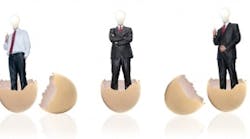In Japanese culture, as perhaps no where else, modesty is prized as a personal trait. So it was that this gaijin’s ears especially perked up when in February 2005, the normally self-effacing Isao Uchida, president and CEO of Yokogawa, announced the company’s intention to be the number one automation supplier in the world by 2010.
The company has since reserved the right to measure its market-share success against its own definition of market served. Even so, Uchida-san’s statement easily surpassed Jim Collins’ BHAG (big, hairy, audacious goal) threshold and, had it been uttered by the leader of almost any other company in Yokogawa’s current market position, it could easily have been dismissed as grandstanding.
It’s nearly two years since Uchida’s announcement, and we’re fast approaching the midway point en route to 2010 and his self-imposed deadline. While it’s difficult to gauge quantitatively where Yokogawa stands in its market-share quest, recent project wins reflect the aggressive moves the company is making to become a more dominant global leader.
As the first—and only—employee of Yokogawa’s New York office in 1957, Uchida himself is uniquely qualified to lead the company in its globalization effort. “It was one small office, but a great first step toward globalization,” Uchida joked in a keynote address to more than 600 industry professionals assembled in December for the company’s North American User Group and Technology Fair in Houston. “Business was not so strong—should say slow—should say almost nothing,” Uchida-san confessed of his time spent on the front lines of the company’s first international efforts.
Today, however, a recently completed, state-of-the-art regional office and demonstration center in Sugarland, Texas, joins eight other new regional offices around the globe built in the past three years. These are to be joined by eight other new offices currently on the drawing board, primarily in energy-producing regions around the world.
Further signs of Yokogawa’s commitment to the marketplace are its reinvestment of 9.3% of revenues into research and development—a mark far surpassing the industry average of less than 3%, reported by the Measurement, Control and Automation Assn. Furthermore, the company plans to boost this investment 30% by 2010, along with a 50% increase in customer support spending, according to Shuzou Kaihori, Yokogawa senior vice president, industrial automation. “Our support and engineering investments embody our commitment,” Kaihori said.
On the exhibit floor of the Technology Fair itself, many of the company’s long-term research projects were on display, garnering a new-found respect for this often quiet company. Among the gee-whiz technology developments demonstrated were a con-focal scanner that provides real-time, three-dimensional imaging of live cell cultures, a medical magnetoencephalograph for observing neuron activity via changes in magnetic fields, chemical micro-reactors and genetic diagnostic systems.
Closer to the industrial automation home front were wireless sensors based on Zigbee technology and version- six Internet protocol (IPv6) chipsets designed to be more secure and easily configurable than today’s version four.
Fiber optic technology is an especially big bet for Yokogawa, with implications for the telecommunications industry as well as industrial automation. On display at the Technology Fair were fully optical packet network components running at 40 Gbps, as well as ultra high-speed systems for testing 160-Gbps fiber-optic switches. “Fiber optic technology is key to the future,” Uchida said, touting their bandwidth, noise immunity and network security advantages.
But it’s not just investments in facilities and technologies that paint a compelling vision for Yokogawa’s future success in a global market. The company also has begun to acknowledge the culturally diverse regions around the world that may best be managed by local talent. The company’s international headquarters, for example, is in the process of being moved from Japan to Singapore. And, closer to home, the first American to be president and CEO of Yokogawa Corp. of America was recently named, with Dave Johnson taking the helm.
“We’ve been understated,” Johnson admitted in his welcoming remarks to the North American User Group assembly, “but that’s all going to change.”




